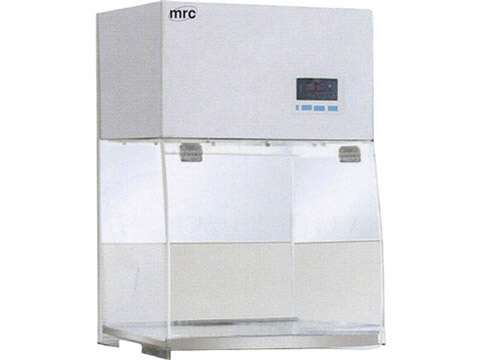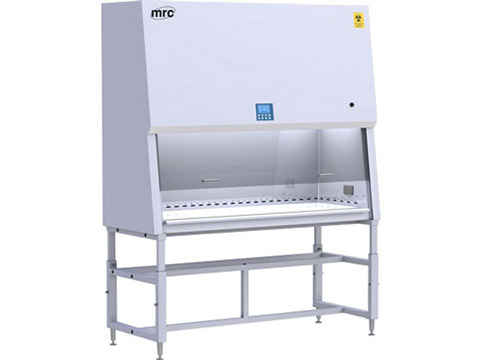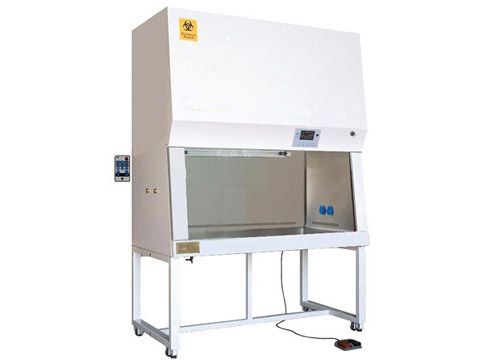Biological safety cabinets (BSCs) are designed to protect the operator, the laboratory environment and work materials from exposure to infectious aerosols and splashes that may be generated when manipulating materials containing infectious agents, such as primary cultures, stocks and diagnostic specimens BSCs, when properly used, have been shown to be highly effective in reducing laboratory-acquired infections and cross-contaminations of cultures due to aerosol exposures. The Biological Cabinets divide to 3 classes: Class I biological safety cabinet, Class II biological safety cabinets, Class III biological safety cabinet.

The Biological Cabinets divide into 3 classes:
Class I biological safety cabinet
The Class I BSC was the first recognized BSC and, because of its simple design, is still in wide use throughout the world. It has the advantage of providing personnel and environmental protection and can also be used for work with radionuclides and volatile toxic chemicals.

Class II biological safety cabinets
The Class II BSC was designed not only to provide personnel protection but also to protect work surface materials from contaminated room air.
Class II BSCs, of which there are four types (A1, A2, B1 and B2), differ from Class I BSCs by allowing only air from a HEPA-filtered (sterile) supply to flow over the work surface.
The Class II BSC can be used for working with infectious agents in Risk Groups 2 and 3.
Class II BSCs can be used for working with infectious agents in Risk Group 4 when positive-pressure suits are used

Class III biological safety cabinet
This type provides the highest level of personnel protection and is used for Risk Group 4 agents. All penetrations are sealed “gas tight”. Supply air is HEPA-filtered and exhaust air passes through two HEPA filters. Airflow is maintained by a dedicated exhaust system exterior to the cabinet, which keeps the cabinet interior under negative pressure (about 124.5 Pa). Access to the work surface is by means of heavy duty rubber gloves, which are attached to ports in the cabinet. Class III BSCs are suitable for work in Biosafety Level 3 and 4 laboratories.

How to work with biological cabinets?
- Wash hands before and after working with the cabinets
- Protective clothing must be worn while using the hood. Long clothing, gloves and a robe.
- Smooth airflow must be maintained in the laboratory
- The vapors must be cleaned regularly
Biological Cabinets Applications
They are most commonly used in biotechnology, pharmaceutical and clinical laboratory processes.A wide range of scientific, research and development organisations within both the commercial and non-commercial sectors, including pharmaceutical, medical, clinical research, defence, education and general healthcare sectors.
Microbiological Research ����:
Used in research labs to handle infectious agents, bacteria, viruses, and fungi. Researchers can safely work with microorganisms without contaminating themselves or the environment.
Cell Culture Work ����:
In cell biology, BSCs protect cell cultures from contamination while preventing any biohazardous substances from escaping into the environment. They maintain sterile conditions, essential for growing healthy cells.
Pharmaceutical Testing & Production ����:
Used to prevent contamination of drugs and to protect lab personnel during the testing and production of pharmaceutical products, especially when handling potentially harmful biological agents.
Handling Infectious Materials ����:
In clinical labs, BSCs are used to safely handle infectious patient samples, blood, tissue, or other bodily fluids that may contain harmful pathogens.
Vaccine Production ����:
During vaccine development, BSCs ensure a contaminant-free environment while handling live viruses or bacteria, reducing the risk of cross-contamination or exposure.
Genetic Engineering ����:
They are also vital in genetic engineering and molecular biology, especially when working with recombinant DNA technology or genetically modified organisms (GMOs).
Animal Research ����:
In animal research, BSCs protect researchers and lab animals from zoonotic diseases (diseases that can spread between animals and humans), while preventing contamination of research samples.
Public Health and Hospital Laboratories ����:
Used in hospitals for diagnostic work related to infectious diseases, protecting healthcare workers and ensuring that the lab environment remains safe.
Areas Around
● The minimal cabinet measurements for the Work Zone are 40” in the front and 12” across each side.
● A least 80” across opposite walls, 60” across opposite bench sections or infrequent traffic areas, and 40” between both the Biological safety cabinet and bench across a vertical wall should be included in the clear zone from around the cabinet.
● The Biological safety cabinets in a room with many BSCs should preferably be spaced. If this isn't possible, a least of 120” between two cabinets opposite one another must be used.
● There must be at least 40” Among if they are put close to each other.
● cabinets must be spaced 48” along each perpendicular wall.
Benefits of using a biosafety cabinet
-Particulate air filter in an excellent way: The polluted air emitted from the cabinet is filtered by a HEPA filter. This filter removes harmful particles and contaminants such as viruses, bacteria and more
-User protection - The actual Cabinet protects the users from pests and bacteria.
-Use of ventilation system Advanced
-Built in an airtight manner
-Several options of biological safety cabinets